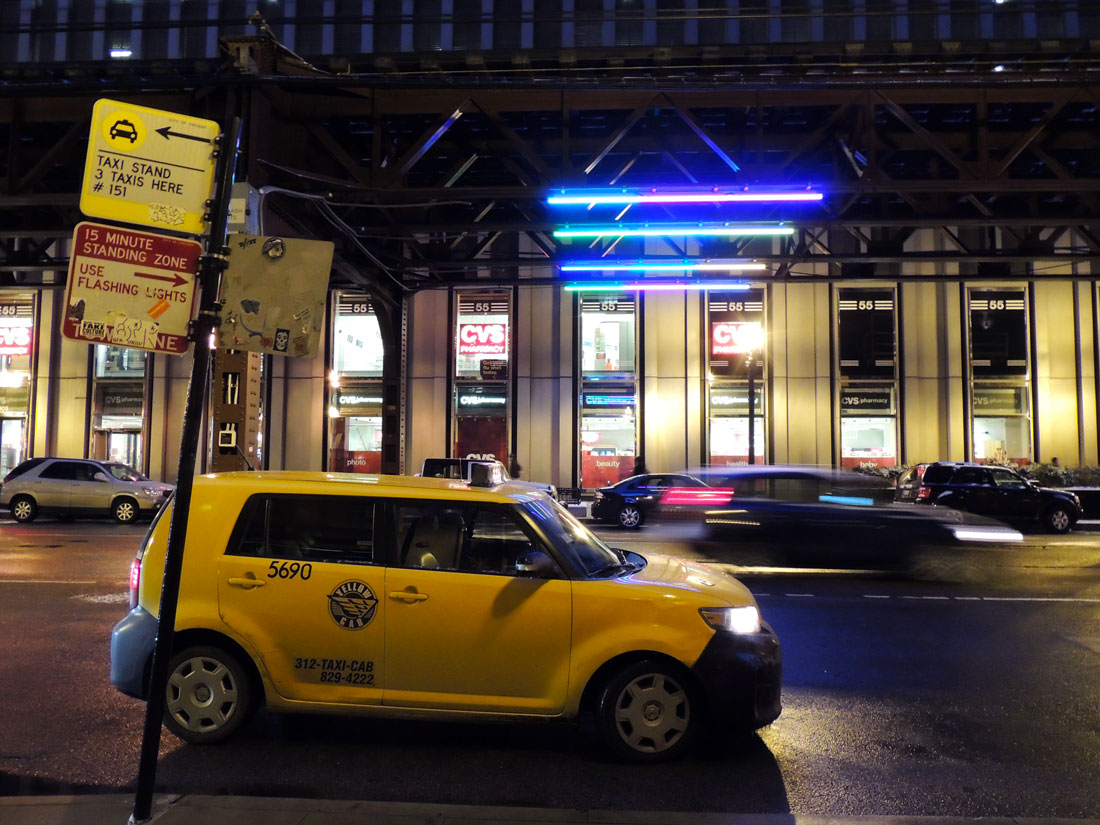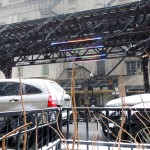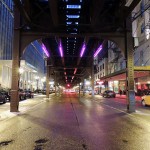By Elizabeth Bacharach
The shadows beneath the el tracks – the underbelly of the city –are starting to glow with multi-colored lights on Wabash Avenue. And the lights may soon become part of a personalized light show that people can program from an app.
The makers of The Wabash Lights are raising contributions to ultimately run the installation along the underside of the train tracks along Wabash from Lake to Van Buren streets. Currently, The Wabash Lights shine between Monroe and Adams streets as part a 6-12 month trial installation funded by a Kickstarter campaign that garnered nearly $60,000 from 918 backers.
Born out of the idea of bringing “the voice of the people” into the conversation of public art the project is meant to be public-funded and public-minded, said Seth Unger, project co-creator and a Chicago design strategist.
Unger said he and his project co-creator Jack Newell are happy with the amount of public support they’ve gotten, both financially and socially. But they’re not stopping here. The men are back fundraising for the next step of The Wabash Lights: making it interactive and programmable through an app.
“One of the coolest aspects of the project, I think, is the ability for anyone in the world to be able to control The Wabash Lights and feel like they’re touching Chicago from anywhere in the world, whether they’re in Chicago or half a world away in another country,” Unger said.
Unger and Newell have been working with Chicago web design company, Table XI, to create an application likely available on smartphones, which will have, what the men are currently calling, “engagement engines.”
Through these “engagement engines,” users will be able to essentially create their own lightshow by choosing options such as “finger painting” or “to upload a video,” said Newell, who is also a Chicago filmmaker. Once complete, users will have the option to publish their creations to a scheduling platform for a five-minute period.
[vimeo 131322692 w=474]
A main concern for making The Wabash Lights interactive is “accessibility” to ensure that the team is able to build a community around the project, said John Gore, director of operations at Table XI.
And such a community is not limited by location.
“Because we have technology, that’s making this idea of public engagement possible in a kind of truly global way,” Newell said, “You can live in India, you can be in Mumbai, you’ve never had an interest to get to Chicago, you don’t want to come here. You can still design The Wabash Lights and know that you have created a public art [experience] that changed the face of Chicago for five or 10 minutes. And that’s pretty cool.”
The importance of modern technology transcends boundaries in this project, as The Wabash Lights is composed of programmable and customizable LED fixtures. Each four-foot tube includes 40 LED lights and is driven by computers housed at the site in a metal box that Newell called “the brains that run the lights.”
Although Unger and Newell had the artistic vision for The Wabash Lights, they consulted Intelligent Lighting Creations (ILC) in Arlington Heights for technical expertise.
“What they were trying to achieve is really only achievable through LED fixtures,” said Matt Pearlman, an account executive at ILC.
Pearlman added that ILC worked with the installing contractor, the Chicago Department of Transportation, and all the other agencies that must approve anything in terms of the tracks to create a “custom mounting detail.” A special clasp affixes the lights to the el tracks, which not only vibrate but also have electrical current from the running trains.

As a whole, The Wabash Lights represents an intersection of art and technology.
“Technology and art are always in this dance back and forth…and I think that’s good. I think that’s what they should do, and I think actually good art should…actually put forward technology in some ways, and technology should be something that’s transcendent of art,” Newell said, drawing on his experience as a filmmaker.
The Wabash Lights are an outlet for “creating something new and unique ever second,” he said. “So, that idea of that ethereal, kind of fleeting, this will never be the same aspect of the project, I think is another kind of high-level bit to consider. It’s important.”
To find out more about to The Wabash Lights: http://www.thewabashlights.com






